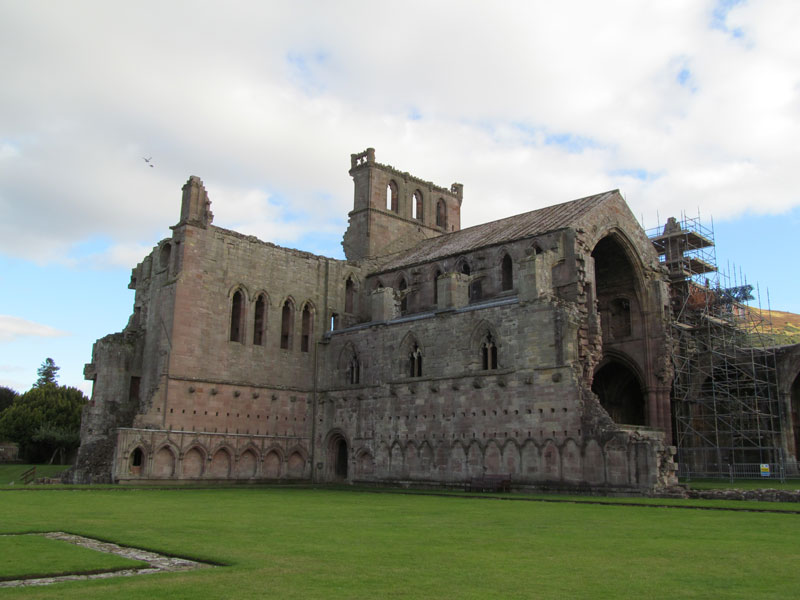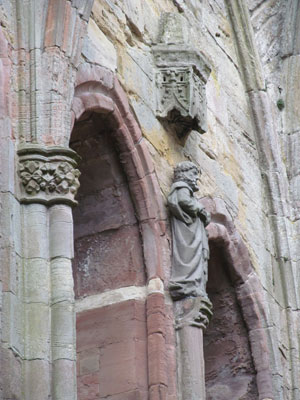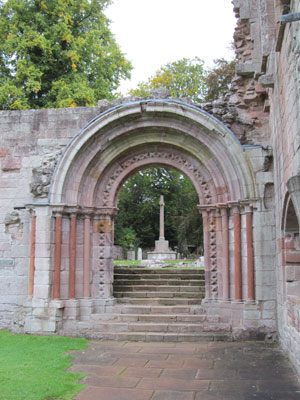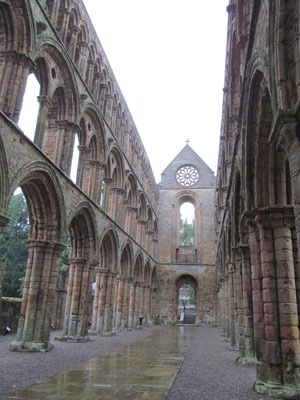Three abbeys in the Scottish Borders
This item appears on page 59 of the June 2014 issue.
Historically, what is called the “Borders” once included not only much of southern Scotland but also neighboring areas of northern England. Today, however, the Borders is just one of 32 council areas of Scotland and is located in the southeastern part of the country. Cumbria and Northumberland in northern England lie to its south and east.
The Scottish Borders has the greatest concentration of medieval abbeys — four of them — in Scotland. These four are located close to each other, within a 46-mile quadrangle, and are easily accessible by car from Edinburgh. On a trip to Scotland in September-October 2013, my husband, Paul, and I visited three of the four abbeys.
Melrose Abbey
The first abbey we visited was Melrose Abbey, situated 40 miles from Edinburgh in a hilly rural area beside the River Tweed. It was founded in 1136 by Cistercian monks only a few miles from where seventh-century Celtic monks had once had an abbey called Mailros, which fell victim to raids by the Scots in the ninth century.
Melrose Abbey, too, was raided, first by English King Edward II’s army in 1322, then by English King Richard II’s in 1385. Rebuilt in Gothic style in the late 14th and early 15th centuries, in 1544 it was once again destroyed by the English when it was desecrated and burned. It never fully recovered from this last disaster, although portions of the abbey church were used as a parish church until 1810.
Even in ruins, Melrose is splendid. Visitors can stroll within the church’s nave and transepts admiring the tracery of the stone windows and the carvings on the vaulted ceiling bosses (for this, you’ll need binoculars or a telephoto camera lens).
Many more carvings adorn the south façade of the church. Looking carefully, visitors can identify gargoyles, dragons, demons, saints, angels, kings, queens and monks. Best is a carving of a pig playing the bagpipe (hard to locate). It’s Melrose’s most famous carving.
Visitors should not miss a chance to take a stroll in the ruins of the cloister, where it’s easy to see where the chapter house, refectory, kitchen and lavatorium (wash place) once stood.
The heart of Robert the Bruce, king of Scotland from 1306 to 1329 and Scotland’s national hero, lies buried in the monks’ cloister. The lay brothers associated with the abbey who did most of the abbey’s manual labor had their own cloister just west of the monks’ cloister.
Dryburgh Abbey
Eight miles southeast of Melrose Abbey lies Dryburgh Abbey. Also situated on the River Tweed, Dryburgh Abbey was founded in 1150. It’s a Premonstratensian abbey where priests, called canons, lived together communally following the rule of St. Augustine.
Dryburgh suffered much the same fate as its nearby neighbor, Melrose. It was burned twice in the 14th century… by Edward II and by Richard II. Rebuilt, it once again was devastated, by fire in 1544, never to recover.
Not much is left inside except for the miraculously well-preserved north transept just off the nave. There lies Sir Walter Scott, one of the best-known writers of the early 19th century, who died in 1832.
The cloister, entered through a spectacular arched-stone doorway on the south side of the church, more than makes up for the almost completely ruined state of the nave. From what’s left, it’s easy to imagine what it must have looked like in the Middle Ages.
The chapter house, where the canons met to discuss abbey business, is intact, even to the paintings on the plaster walls, still visible after almost 900 years. Also intact is the warming room, where canons could enjoy a fire on frigid days.
There’s a parlor, now housing carved masonry, where canons could converse, as well as the remnants of a dormitory above it. Not much remains of the refectory except for a gable with a beautiful, 12-petal rose window.
Jedburgh Abbey
Jedburgh Abbey is located 12½ miles southeast of Dryburgh Abbey beside a river called the Jed Water. It was founded in 1138 by the Scottish King David I and Bishop John of Glasgow for Augustinian canons (priests), who combined preaching with the contemplative life of the abbey.
Jedburgh’s position, close to the English border (only 10 miles away), plus the presence of Jedburgh Castle nearby insured that the abbey seesawed between the Scots and the English.
During the Wars of Independence against England, the English king, Edward I, lodged in the abbey. During the 15th century, there were attacks in 1409, 1410, 1416 and 1464. In 1523, the abbey was burned by the Earl of Surrey. Further attacks by the English in 1544 and 1545 led to destruction from which the abbey never recovered, although a parish church was built within the ruins afterward.
Much is left of the abbey church: the west façade, with a magnificent 12th-century entrance; the 3-tiered Gothic-style nave; the Romanesque choir, and two ornately carved north doorways leading into the cloister.
The cloister did not fare as well as the nave, and little remains, but it is still possible to trace where major abbey buildings once stood, including the chapter house, the refectory and the abbot’s lodging. In the cloister, there’s now a lovely garden planted with medicinal and culinary herbs that once might have flourished there in medieval times.
If I could choose just one abbey to visit, it would be difficult. I’d go to Melrose for the sculptures and carvings; to Dryburgh for the park-like beauty of its setting and to pay my respects to Sir Walter Scott, and to Jedburgh for its awesome majesty.
There was one additional abbey we would have liked to visit, Kelso Abbey, 11 miles northeast of Jedburgh. Kelso was a Benedictine abbey founded in 1128 at the same time as the other great Scottish Borders abbeys. We just didn’t have enough time. However, we considered ourselves fortunate to have visited three of the four superlative Borders abbeys.
If you go…
Although the actual numbers of miles between the abbeys are not great, allow time to drive from one to the other to enjoy the scenery.
I don’t recommend visiting all three (or four, if you include Kelso Abbey) in one day. There’s the danger of getting “abbeyed out.” We combined Melrose Abbey with a visit to Sir Walter Scott’s home at Abbotsford only two miles away, leaving Dryburgh and Jedburgh abbeys for another day.
The website www.historic-scotland.gov.uk provides background information on all three abbeys. (Type an abbey’s name in the Keyword Search box and, among the results, click on one that says “property,” then [except for Kelso Abbey] click on “About the property” for background information or on “Plan your visit” for directions to the abbey, admission fees, opening hours and a phone number.)
Each abbey is open daily 9:30 to 5:30 April to September and 9:30 to 4:30 October to March. There were no lines at any of the sites during our September visits.
Admission cost £5.50 (about $9) at Melrose and Jedburgh and £5 at Dryburgh. Each abbey sold an excellent guidebook for about £4.




